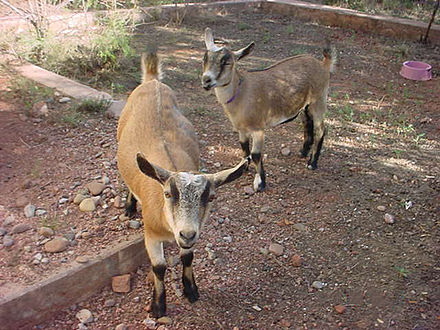The Nigerian Dwarf is a modern American breed of dwarf goat. Like the American Pygmy Goat, it derives from the West African Dwarf group of breeds of West Africa.[4]: 416
Between about 1930 and 1960 a variety of small goats of the West African Dwarf group of breeds were imported from Africa to the United States to be exhibited in zoos.[2] The Nigerian Dwarf, like the American Pygmy Goat, derives from these, but does not resemble the stocky West African Dwarf in conformation – it has been bred to have the appearance of a miniature dairy goat.[4]: 399 [5]: 35 It was at first reared as a show breed and companion animal; selection was for appearance and for docility.[2] It was later found to be suitable for small-scale dairy production, and some breeding was directed towards dairy qualities.[2] A herd-book was established in 1980.[3]
Numbers grew rapidly; by 2002 there were almost 7000 head registered.[2] The breed was recognized by the American Dairy Goat Association in 2005.[5]: 33 The Nigerian Dwarf was formerly listed on the heritage breeds watchlist of the Livestock Conservancy as "recovering",[2] but was removed from the list in 2013.[6]
In 2023 the total number of the goats in the United States was just under 40000;[3] populations numbering 1000–2000 head are reported by Australia and Canada.[7] In 2024 the international conservation status of the breed was "not at risk".[7]
In the 1990s the Nigora breed was created by cross-breeding the Nigerian Dwarf with Angora and other mohair breeds.[4]: 399
On March 14, 2024, the first Nigerian Dwarf goat was born in the UK through a surrogate mother of a different breed via IVF.[8][9] This method was employed due to import restrictions, which prohibit the direct importation of live Nigerian Dwarf goats into the country.

The Nigerian Dwarf is small but well-proportioned; its conformation resembles that of larger dairy goats.[4]: 399 It may be horned or naturally hornless.[2] The coat is fine and fairly short, and may be of any color, or multicolored;[2] common colors are gold, chocolate and black, frequently with white markings. The facial profile may be concave or straight; the ears are upright.[4]: 399 The average weight is approximately 35 kg (75 lb), while maximum height is about 60 cm (24 in) for males and slightly less for females;[4]: 399 stock bred for dairy performance may be rather larger than show or companion animals.[2]
It is a precocious breed – young stock may be bred from an early age: males from about three months, females from seven or eight months.[10] The gestation period is in the range 145–153 days;[10] the twinning rate is high, and triplet and quadruplet births are not uncommon.[4]: 399 [2] Life expectancy is from eight to 12 years.[10]

The Nigerian Dwarf was originally bred for show and as a companion animal. It was later also bred for dairy use.[2] Average milk yield of dairy stock is 340 kg (750 lb) per year;[11]: 284 a yield of 993 kg (2190 lb) in a lactation of 305 days was recorded in 2018.[12]: 3 Lactation usually lasts for about ten months.[2] The milk is high in butterfat and protein, averaging 6.5% and 3.9% respectively,[11]: 284 and is suitable for making cheese and butter.[2]
{{cite encyclopedia}}: Missing or empty |title= (help)